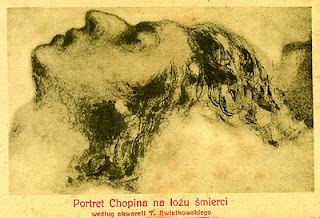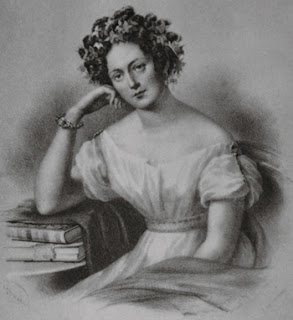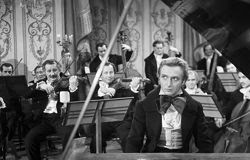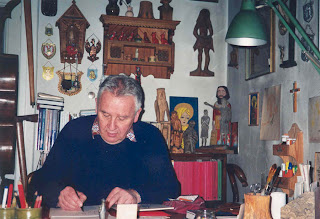 In America, December is the holiday season. Houses are decorated starting on December 1 and each weekend brings at least four party invitations, luncheons, dinners, and Christmas carols sing-alongs. By the second week of January all of it will be thrown out or packed away and the Christmas season will recede into the distance.
In America, December is the holiday season. Houses are decorated starting on December 1 and each weekend brings at least four party invitations, luncheons, dinners, and Christmas carols sing-alongs. By the second week of January all of it will be thrown out or packed away and the Christmas season will recede into the distance. The calendar of celebrations looked somewhat different in Chopin's Paris: yes, there were gatherings in December, but the real party season started with the Christmas day, and went on and on, until the end of Carnaval in early February. The rustle of taffeta and richly colored velvets, the glimmer of candlelight, jewels sparkling like laughter... Kerri Buckley's poem "The Songs of Chopin: A Villanelee" published in Chopin with Cherries captures the mood of the seaso, while looking back at the romantic salons frequented by Chopin:
The Sounds of Chopin: A Villanelle
by Kerri Buckley
Hearts open like French doors as Chopin plays
At his birth, cherry blossoms were splashed with snow
Entering sound deeply changes ways one prays
His concertos have filled cafes, chateaus, chalets
Inspiring toasts with brandy, champagne, or Bordeaux
Hearts are open French doors when Chopin plays
Faces aglow, women wear taffeta, velvet, brocades
Join men in bow ties, gloves, a man gleams in a tuxedo
Slipping into glissandos changes how he deeply prays
Intoxicating Nocturnes brightly sets one’s soul ablaze
Chords slice air like fire batons atop the high crescendo
Hearts could burst like French doors if Chopin plays
Lovers’ lips shine like sugar, chocolate, cherry glacés
In hours most arrive, sweethearts steal away, dolce adagio
Entering melodies softly changes ways a beloved prays
Composers’ lives overflow in continuous, sacred praise
Onstage below glimmer of candelabras, maestros glow
Hearts glisten, French doors wide open as Chopin plays
Enter music to change all deep mystical ways one prays
____________________________________________
The rotational and repetitive character of the villanelle is well suited to the subject, filled with the turns of the waltz, and the alluring moods of the evening. Kerri gave us a wonderful holiday gift in this poem. The online editor programs do not allow extra spaces which separate phrases and words, so the layout of the poem is somewhat faulty. This should not detract the readers from its beauty.
Chopin was a creature of the aristocratic salon, elegant and refined. He liked to remember the simple music of Polish countryside, including folk dances and carols. He transformed the cited or stylized music to the universal level. The beloved lullaby carol, "Lulajze Jezuniu" appears in Chopin's Scherzo in B-minor, Op 20, written in 1831-32 and dedicated to his friend Thomas Albrecht. The sweet melody appears in the central, slow section of the Scherzo, marked Molto Piu Lento.
I selected several recordings of this lovely Christmas Carol and its version in the Scherzo to share with Chopin lovers this Christmas.

- Chopin's Scherzo in B Minor, Op. 20 by Claudio Arrau (10'24''), the carol starts at 4'05''
- Another, later and slower version of Chopin's Scherzo by Claudo Arrau (10:50), the carol-lullaby starts at 4'40''
- Chopin's Scherzo in B Minor, Op. 20, by Jozef Hoffmann (abbreviated, 4'42''), the carol starts at 1'47'' - of historical interest
- Chopin's Scherzo in B Minor, Op. 20, by Artur Rubinstein (8'17''), the carol starts at 3' - a historical recording
- A traditional choral version of Lulajze Jezuniu by The Polish State Folk Song and Dance Ensemble Mazowsze. The singers wear traditional cosumes from the village Kocierzew, near Łowicz in the Mazovia region.
- A jazz arrangement of the Chopin's version by a Polish vocal quartet, Novi Singers: Novi Singers sing Chopin
- An orchestral arrangement of Lulajze Jezuniu by Tomasz Chmiel, with soprano Grażyna Brodzińska, Adama Szerszen, chorus PAT "Psalmodia" and Symphony Orchestra of M.Karłowicz Music School in Krakow: "Krakowska Młoda Filharmonia" conducted by Tomasz Chmiel
- An extensive choral arrangement of Lulajze Jezuniu with chorus and orchestra by the Polish State Folk Song and Dance Ensemble, Slask
- Another blog about Chopin and his lullaby: http://austenetterespublica.wordpress.com
____________________________
For my Poetry Laurels blog, I created a couple of illustrations to my Christmas poems, one from this year and one from 2009. In early December, I was asked to read some poems at a party and realized that I have not written my annual Christmas poem yet. It came to me in the rain, when I could barely see the road ahead and the sky was heavy with darkness.

Did you know?
Some Christmases are rainy
Tears fall from overcast sky
On lonely crowds in hospitals
And prison yards
Sometimes Christmas is icy
Frozen under the pale moon
Changing faces into lifeless
Shadows at night
Some Christmases are scarlet
And green like fir garlands and hearts
Warmed by barszcz and hot chocolate,
Evenings by the fire
Sometimes Christmas is white
Snowflakes melt on my gloves
The thin wafer of opłatek we break
Shelters us in good wishes
Some Christmases are sparkly
With the tinsel of laughter
Giggling children unwrap gifts
Magic in the morning
My Christmas is golden
Like that first star of Wigilia,
Warm kisses with kompot and kutia
Blessings under the tree
© 2011 by Maja Trochimczyk
I paired this poem with a photo I took this October at the Notre Dame Cathedral in Paris. I liked the open window, looking out through the multitude of shapes and colors onto a simpler, luminous world.

The picture became the cover of my Christmas card. I also reprinted my last year's holiday poem, "Rules for Happy Holy Days" as a reminder about the importance of celebrating the holidays in the right way, by sharing and loving. This poem was written for my last year's Christmas wishes. These Rules are timeless.

Rules for Happy Holy Days
Don’t play Christmas carols
at the airport. Amidst the roar
of jet engines, they will spread
a blanket of loneliness
over the weary, huddled masses,
trying not to cry out for home.
Don’t put Christmas light on a poplar.
With branches swathed in white
galaxies, under yellow leaves, the tree
will become foreign, like the skeleton
of an electric fish, deep in the ocean.
Clean the windows from the ashes
of last year’s fires. Glue the wings
of a torn paper angel. Brighten
your home with the fresh scent
of pine needles and rosemary.
Take a break from chopping almonds
to brush the cheek of your beloved
with the back of your hand,
just once, gently. Smile and say:
“You look so nice, dear,
you look so nice.”
© 2009 by Maja Trochimczyk

_____________________________________
NOTES:
Photographs and Christmas poems (c) 2011 by Maja Trochimczyk
Christmas tree decorations by Eva DiAngelo, California



































